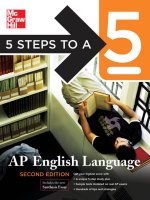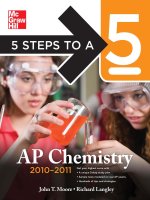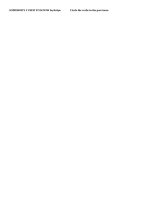5 steps to a 5 500 AP chemistry questions to know by test day 1st edition (2011)
Bạn đang xem bản rút gọn của tài liệu. Xem và tải ngay bản đầy đủ của tài liệu tại đây (2.77 MB, 217 trang )
5 STEPS TO A 5™
500 AP Chemistry Questions to Know by Test Day
5 STEPS TO A 5™
500 AP Chemistry Questions to Know by Test Day
Mina Lebitz
Get ready for your AP exam with McGraw-Hill’s 5 STEPS TO A 5: 500 AP Chemistry Questions
to Know by Test Day!
Also in the 5 Steps series:
5 Steps to a 5: AP Chemistry
Also in the 500 AP Questions to Know by Test Day series:
5 Steps to a 5: 500 AP Biology Questions to Know by Test Day
5 Steps to a 5: 500 AP Calculus Questions to Know by Test Day
5 Steps to a 5: 500 AP English Language Questions to Know by Test Day
5 Steps to a 5: 500 AP English Literature Questions to Know by Test Day
5 Steps to a 5: 500 AP Environmental Science Questions to Know by Test Day
5 Steps to a 5: 500 AP European History Questions to Know by Test Day
5 Steps to a 5: 500 AP Human Geography Questions to Know by Test Day
5 Steps to a 5: 500 AP Microeconomics/Macroeconomics Questions to Know by Test Day
5 Steps to a 5: 500 AP Physics Questions to Know by Test Day
5 Steps to a 5: 500 AP Psychology Questions to Know by Test Day
5 Steps to a 5: 500 AP Statistics Questions to Know by Test Day
5 Steps to a 5: 500 AP U.S. Government & Politics Questions to Know by Test Day
5 Steps to a 5: 500 AP U.S. History Questions to Know by Test Day
5 Steps to a 5: 500 AP World History Questions to Know by Test Day
Copyright © 2012 by The McGraw-Hill Companies, Inc. All rights reserved. Except as permitted
under the United States Copyright Act of 1976, no part of this publication may be reproduced or
distributed in any form or by any means, or stored in a database or retrieval system, without the prior
written permission of the publisher.
ISBN: 978-0-07-177406-2
MHID:
0-07-177406-8
The material in this eBook also appears in the print version of this title: ISBN: 978-0-07-177405-5,
MHID: 0-07-177405-X.
eBook conversion by codeMantra
Version 2.0
All trademarks are trademarks of their respective owners. Rather than put a trademark symbol after
every occurrence of a trademarked name, we use names in an editorial fashion only, and to the benefit
of the trademark owner, with no intention of infringement of the trademark. Where such designations
appear in this book, they have been printed with initial caps.
McGraw-Hill eBooks are available at special quantity discounts to use as premiums and sales
promotions, or for use in corporate training programs. To contact a representative please e-mail us at
Trademarks: McGraw-Hill, the McGraw-Hill Publishing logo, 5 Steps to a 5, and related trade dress
are trademarks or registered trademarks of The McGraw-Hill Companies and/or its affiliates in the
United States and other countries and may not be used without written permission. All other
trademarks are the property of their respective owners. The McGraw-Hill Companies is not
associated with any product or vendor mentioned in this book.
AP, Advanced Placement Program, and College Board are registered trademarks of the College
Entrance Examination Board, which was not involved in the production of, and does not endorse, this
product.
TERMS OF USE
This is a copyrighted work and The McGraw-Hill Companies, Inc. (“McGraw-Hill”) and its
licensors reserve all rights in and to the work. Use of this work is subject to these terms. Except as
permitted under the Copyright Act of 1976 and the right to store and retrieve one copy of the work,
you may not decompile, disassemble, reverse engineer, reproduce, modify, create derivative works
based upon, transmit, distribute, disseminate, sell, publish or sublicense the work or any part of it
without McGraw-Hill’s prior consent. You may use the work for your own noncommercial and
personal use; any other use of the work is strictly prohibited. Your right to use the work may be
terminated if you fail to comply with these terms.
THE WORK IS PROVIDED “AS IS.” McGRAW-HILL AND ITS LICENSORS MAKE NO
GUARANTEES OR WARRANTIES AS TO THE ACCURACY, ADEQUACY OR
COMPLETENESS OF OR RESULTS TO BE OBTAINED FROM USING THE WORK,
INCLUDING ANY INFORMATION THAT CAN BE ACCESSED THROUGH THE WORK VIA
HYPERLINK OR OTHERWISE, AND EXPRESSLY DISCLAIM ANY WARRANTY, EXPRESS
OR IMPLIED, INCLUDING BUT NOT LIMITED TO IMPLIED WARRANTIES OF
MERCHANTABILITY OR FITNESS FOR A PARTICULAR PURPOSE. McGraw-Hill and its
licensors do not warrant or guarantee that the functions contained in the work will meet your
requirements or that its operation will be uninterrupted or error free. Neither McGraw-Hill nor its
licensors shall be liable to you or anyone else for any inaccuracy, error or omission, regardless of
cause, in the work or for any damages resulting therefrom. McGraw-Hill has no responsibility for the
content of any information accessed through the work. Under no circumstances shall McGraw-Hill
and/or its licensors be liable for any indirect, incidental, special, punitive, consequential or similar
damages that result from the use of or inability to use the work, even if any of them has been advised
of the possibility of such damages. This limitation of liability shall apply to any claim or cause
whatsoever whether such claim or cause arises in contract, tort or otherwise.
CONTENTS
About the Author
Introduction
Note from the Author
Chapter 1 Atomic Theory and Structure
Questions 1–50
Chapter 2 Chemical Bonding
Questions 51–90
Chapter 3 States of Matter
Questions 91–150
Chapter 4 Solutions
Questions 151–180
Chapter 5 Chemical Reactions
Questions 181–230
Chapter 6 Thermodynamics
Questions 231–269
Chapter 7 Kinetics
Questions 270–300
Chapter 8 Equilibrium
Questions 301–330
Chapter 9 Acid–Base Chemistry
Questions 331–361
Chapter 10 Electrochemistry
Questions 362–387
Chapter 11 Nuclear Chemistry
Questions 388–408
Chapter 12 Descriptive
Questions 409–428
Chapter 13 Laboratory Procedure
Questions 429–444
Chapter 14 Data Interpretation
Questions 445–500
Answers
ABOUT THE AUTHOR
Mina Lebitz has a BS in biology from the State University of New York at Albany and an MS in
nutritional biochemistry from Rutgers University. She has more than 16 years of teaching experience
at both the high school and college level. Ms. Lebitz received the New York Times’ Teachers Who
Make a Difference award in 2003 during her tenure at Brooklyn Technical High School and was the
senior science tutor at one of the most prestigious tutoring and test prep agencies in the United States.
Currently, she is doing research, writing, and assisting students in reaching their academic goals,
while continuing to learn everything she can about science. Her website is www.idigdarwin.com.
INTRODUCTION
Congratulations! You’ve taken a big step toward AP success by purchasing 5 Steps to a 5: 500 AP
Chemistry Questions to Know by Test Day. We are here to help you take the next step and earn a high
score on your AP Exam so you can earn college credits and get into the college or university of your
choice.
This is book gives you 500 AP-style multiple-choice questions that cover all the most essential
course material. Each question has a detailed answer explanation. These questions will give you
valuable independent practice to supplement both your regular textbook and the groundwork you are
already covering in your AP classroom. This and the other books in this series were written by expert
AP teachers who know your exam inside and out and can identify crucial exam information and
questions that are most likely to appear on the test.
You might be the kind of student who takes several AP courses and needs to study extra questions
a few weeks before the exam for a final review. Or you might be the kind of student who puts off
preparing until the last weeks before the exam. No matter what your preparation style is, you will
surely benefit from reviewing these 500 questions that closely parallel the content, format, and degree
of difficulty of the questions on the actual AP exam. These questions and their answer explanations
are the ideal last-minute study tool for those final few weeks before the test.
Remember the old saying “Practice makes perfect.” If you practice with all the questions and
answers in this book, we are certain you will build the skills and confidence needed to do great on
the exam. Good luck!
—Editors of McGraw-Hill Education
NOTE FROM THE AUTHOR
The AP Chemistry exam has a multiple-choice section during which you are not allowed to use a
calculator. In this section, you can round fairly generously to solve problems faster. However, do not
round generously in the free-response problems. Calculators are allowed for most of the freeresponse section so you’re expected to be precise in your calculations (and obey the rules for
significant figures).
The questions in this book cover the material for both the free-response and multiple-choice
sections of the AP Chemistry exam. Some calculations are best done with a calculator, but all of them
can be done without one. In the multiple-choice section of the AP Chemistry exam, there will never
be a problem that requires the correct answer from a different question to solve. To cover all the
material related to the exam in this book, topics from free-response questions have been adapted into
multiple-choice style questions. This required that some questions occur in groups referring to a
common experiment or data set. These questions may rely on answers from other questions.
5 STEPS TO A 5™
500 AP Chemistry Questions to know by test day
CHAPTER 1
Atomic Theory and Structure
1. Which of the following shows the correct number of protons, neutrons, and electrons in a
neutral cadmium-112 atom?
Questions 2–7 refer to the following diagram of the periodic table.
2. Reacts violently with water at 298 K
3. Highest first ionization energy
4. Highest electronegativity
5. Highest electron affinity
6. Largest atomic radius
7. Most metallic character
8. The atomic mass of bromine is 79.904. Given that the only two naturally occurring isotopes are
79Br and 81Br, the abundance of 79Br isotope is approximately:
(A) 20 percent
(B) 40 percent
(C) 50 percent
(D) 80 percent
(E) 99 percent
9. The atomic mass of Sr is 87.62. Given that there are only three naturally occurring isotopes of
strontium, 86Sr, 87Sr, and 88Sr, which of the following must be true?
(A) 86Sr is the most abundant isotope.
(B) 87Sr is the most abundant isotope.
(C) 88Sr is the most abundant isotope.
(D) 86Sr is the least abundant isotope.
(E) The isotopes 87Sr and 88Sr occur in approximately equal amounts.
10. Which of the following properties generally decreases from left to right across a period (from
potassium to bromine)?
(A) Electronegativity
(B) Electron affinity
(C) Atomic number
(D) Atomic radius
(E) Maximum value of oxidation number
11. All of the following statements describe the elements of the group 1 alkali metals (not including
hydrogen) except:
(A) Their reactivity increases with increasing period number.
(B) They have low first ionization energies.
(C) They react violently with water to form strong acids.
(D) They have strong metallic character.
(E) They are all silver solids at 1 atm and 298 K.
12. Which of the following elements would be expected to have chemical properties most similar
to those of phosphorus?
(A) S
(B) Se
(C) O
(D) As
(E) Si
13. Which of the following pairs are isoelectronic (have the same number of electrons)?
(A) Kr−, Br+
(B) F−, Na+
(C) Sc, Ti−
(D) Be2+, Ne
(E) Cs, Ba2+
14. Which of the following ions has the same number of electrons as I−?
(A) Sr2+
(B) Rb+
(C) Cs+
(D) Ba2+
(E) Br−
15. Which of the following best explains why the F−ion is smaller than the O2– ion?
(A) F− has a more massive nucleus than O2–.
(B) F− has a higher electronegativity than O2–.
(C) F− has a greater nuclear charge than O2–.
(D) F− has a greater number of electrons than O2–.
(E) F− has more nucleons and electrons than O2–.
16. All of the following are true statements about the periodic table except:
(A) The reactivity of the group 1 alkali metals increases with increasing period.
(B) The reactivity of the group 17 halogens decreases with increasing period.
(C) The group 1 and 2 metals react with water to form basic solutions.
(D) The group 18 noble gases can exist only as inert, monatomic gases.
(E) All elements with an atomic number equal to or greater than 84 are radioactive.
17. Which of the following lists contains all the diatomic, elemental gases at standard temperatures
and pressures?
(A) H, N, O
(B) H, N, O, F, Cl
(C) H, N, O, F, Cl, Br, I
(D) H, N, O, Cl, Br, I, Hg, Rn
(E) H, N, O, Cl, He, Ne, Ar, Kr, Xe, Rn
18. As atomic number increases from 11 to 17 in the periodic table, what happens to atomic
radius?
(A) It remains constant.
(B) It increases only.
(C) It decreases only.
(D) It increases, then decreases.
(E) It decreases, then increases.
19. The effective nuclear charge experienced by a valence Kr is different than the effective nuclear
charge experienced by a valence electron of K. Which of the following accurately illustrates
this difference?
(A) K is a solid while Kr is a gas.
(B) The valence electrons of Kr have a lower first ionization energy than K.
(C) The proton-to-electron ratio is higher for Kr than for K.
(D) Kr has a higher first ionization energy than K.
(E) The valence electrons of Kr experience less shielding by the inner electrons than the
valence electrons of K.
20. Based on the ionization energies for element X listed in the table above, which of the following
elements is X most likely to be?
(A) Li
(B) Be
(C) Al
(D) Si
(E) As
Questions 21 and 22 refer to the following graph of first ionization energies.
21. Correct explanations for the large drops in ionization energies between elements of atomic
numbers 2 and 3, 10 and 11, and 18 and 19 occurs because, compared to elements 3, 11, and
19, elements 2, 10, and 18 have
I. smaller atomic radii.
II. a greater electron affinity.
III. a greater effective nuclear charge.
(A) I only
(B) II only
(C) III only
(D) I and III only
(E) I, II, and III
22. Correct explanations for the increases and decreases in ionization energies between elements
between atomic numbers 2 and 10 (and 11 and 18) include:
I. There is repulsion of paired electrons in the p4 configuration.
II. The electrons in a filled s orbital are more effective at shielding the electrons in the p
orbitals of the same n than each other.
III. Filled orbitals and subshells are more stable than unfilled orbitals and subshells.
(A) I only
(B) II only
(C) III only
(D) I and II only
(E) I, II, and III
23. Which of the following chemical species is correctly ordered from smallest to largest radius?
(A) P < S < Cl
(B) Ne < Ar < Kr
(C) F < O < O2–
(D) K < K+ < Rb
(E) Na+ < Mg2+ < Na
24. Which of the following electron configurations represents an atom in an excited state?
(A) 1s22s22p5
(B) 1s22s22p53s2
(C) 1s22s22p63s1
(D) 1s22s22p63s23p5
(E) 1s22s22p63s23p64s1
Questions 25–28 refer to the ground state atoms of the following elements:
(A) Ga
(B) Tc
(C) C
(D) S
(E) N
25. This atom contains exactly one unpaired electron.
26. This atom contains exactly two unpaired electrons.
27. This atom contains exactly two electrons in the highest occupied energy sublevel.
28. This element is radioactive.
Questions 29–35 refer to the following:
29. A highly reactive, ground state metal
30. Highest first ionization energy
31. An atom in the excited state
32. An atom that forms a trigonal planar molecule when saturated with hydrogen
33. Has exactly five valence electrons
34. The most abundant element in Earth’s atmosphere
35. A chemically unreactive atom
Questions 36–42 refer to the following:
36. An atom in the excited state
37. An atom whose aqueous cation is colored
38. A chemically unreactive atom
39. An atom that forms an alkaline solution and hydrogen gas when combined with water
40. An atom with the highest second ionization energy
41. An atom that forms colored compounds
42. A highly reactive metal
43. Which of the following is the most accurate interpretation of Rutherford’s experiment in which
he bombarded gold foil with alpha particles?
(A) Electrons are arranged in shells of increasing energy around the nucleus of an atom.
(B) The volume of an atom is mostly empty space with the positive charges concentrated in a
dense nucleus.
(C) Protons and neutrons are more massive than electrons but take up less space.
(D) Atoms are made of subatomic particles of different charges and masses.
(E) Discrete emissions spectrum lines are produced because only certain energy states of
electrons are allowed.
44. All of the halogens in their element form at 25°C and 1 atm are:
(A) Gases
(B) Colorless
(C) Odorless
(D) Negatively charged
(E) Diatomic molecules
Questions 45–49 refer to the following choices:
(A) Alkali metals
(B) Noble gases
(C) Halogens
(D) Transition elements
(E) Actinides
45. The most likely to form anions
46. Their monovalent cations form clear solutions
47. Have the highest ionization energies in a given period
48. All are radioactive
49. The most difficult to oxidize in a given period
50. Two unknown, solid substances are analyzed in a lab. The results are shown above. True
statements about the composition of these two substances include:
I. Substance 1 contains an alkali metal.
II. Substance 2 contains an alkali earth metal.
III. Substance 2 contains a transition metal.
(A) I only
(B) II only
(C) III only
(D) I and II only
(E) I and III only
CHAPTER 2
Chemical Bonding
51. Which of the following compounds has the greatest ionic character?
(A) SiO2
(B) ClO2
(C) CH4
(D) AlF3
(E) SO2
52. Which of the following compounds has the greatest lattice energy?
(A) KCl
(B) NaCl
(C) CaCl2
(D) MgCl2
(E) FeCl3
53. Which of the following is the correct name for the compound with the chemical formula
Mg3N2?
(A) Trimagnesiumdinitrogen
(B) Trimagnesiumdinitride
(C) Magnesium nitrogen
(D) Magnesium nitrate
(E) Magnesium nitride
Questions 54 and 55 refer to the following choices:
(A) N2
(B) F2
(C) O3
(D) NH3
(E) CO2
54. Has one or more bonds with a bond order of 1.5
55. Has one or more bonds with a bond order of 3
56. If metal X forms an ionic chloride with the formula XCl2, which of the following is most likely
the formula for the stable phosphide of X?
(A) XP2
(B) X2P3
(C) X3P2
(D) X2(PO4)3
(E) X3(PO4)2
57. In which of the following processes are covalent bonds broken?
(A) C10H8(s) → C10H8(g)
(B) C(diamond) → C(graphite)
(C) NaCl(s) → NaCl(molten)
(D) KCl(s) → KCl(aq)
(E) NH4NO3(s) → NH4+(aq) + NO3−(aq)
58. In which of the following processes are covalent bonds broken?
(A) Solid sodium chloride melts.
(B) Bronze (an alloy of copper and tin) melts.
(C) Table sugar (sucrose) dissolves in water.
(D) Solid carbon (graphite) sublimes.
(E) Solid carbon dioxide (dry ice) sublimes.
59. Diamond is an extremely hard substance. This quality is best explained by the fact that a
diamond crystal
(A) is ionic with a high lattice energy.
(B) is made completely of carbon, a very hard atom.
(C) is formed only under extremely high heat and pressure.
(D) has many delocalized electrons that contribute to greater van der Waal forces.
(E) is one giant molecule in which each atom forms strong bonds with each of its neighbors.
Questions 60–65 refer to the following answer choices:
(A) PCl5
(B) BH3
(C) NH3
(D) CO2
(E) SO2
60. The molecule with trigonal pyramidal molecular geometry
61. The molecule with trigonal bipyramidal molecular geometry
62. The molecule with trigonal planar molecular geometry
63. The molecule with bent molecular geometry
64. The molecule with linear molecular geometry
65. The molecule with tetrahedral electron pair geometry
Questions 66–70 refer to the following answer choices:
(A) C3H8
(B) C6H6
(C) H2O
(D) CO2
(E) CH2O
66. The molecule with the largest dipole moment
67. The molecule with the greatest number of π (pi) bonds
68. The molecule with the greatest number of σ (sigma) bonds
69. The molecule that contains a central atom with sp hybridization
70. The molecule with exactly one double bond
Questions 71–76 refer to the following answer choices:
(A) CO
(B) C2H4
(C) PH3
(D) HF
(E) O2
71. Has the largest dipole moment
72. Contains two π (pi) bonds
73. A necessary reactant for combustion reactions
74. Has trigonal pyramidal electron pair geometry
75. Contains the most σ (sigma) bonds
76. One of two allotropes of an element found in Earth’s atmosphere
Questions 77–80 refer to the following answer choices:
(A) CCl4
(B) CO2
(C) H2O
(D) BH3
(E) NH3
77. This molecule has exactly 2 double bonds.
78. This molecule has the largest dipole moment.
79. This molecule has a trigonal planar molecular geometry.
80. This molecule has a trigonal pyramidal molecular geometry.
81. Types of hybridization exhibited by C atoms in ethane include which of the following?
I. sp
II. sp2
III. sp3
(A) I only









